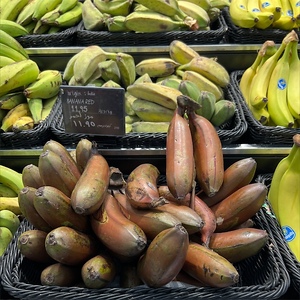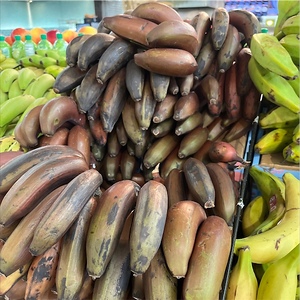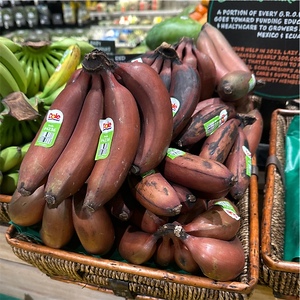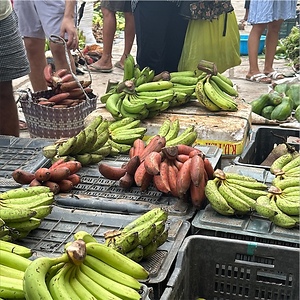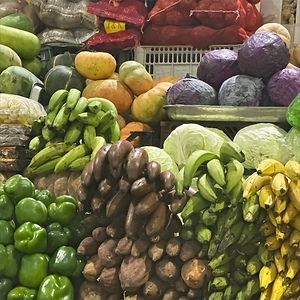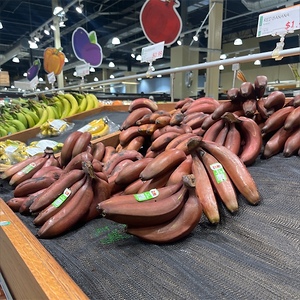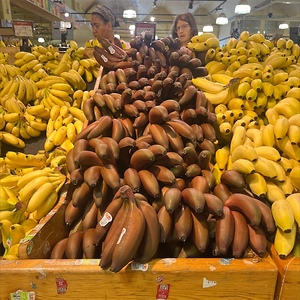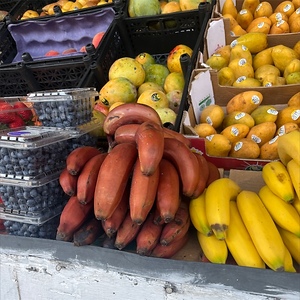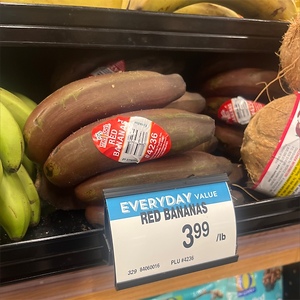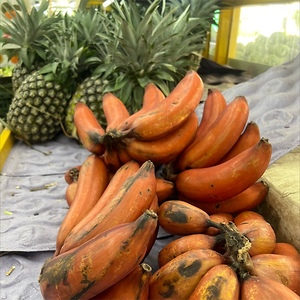

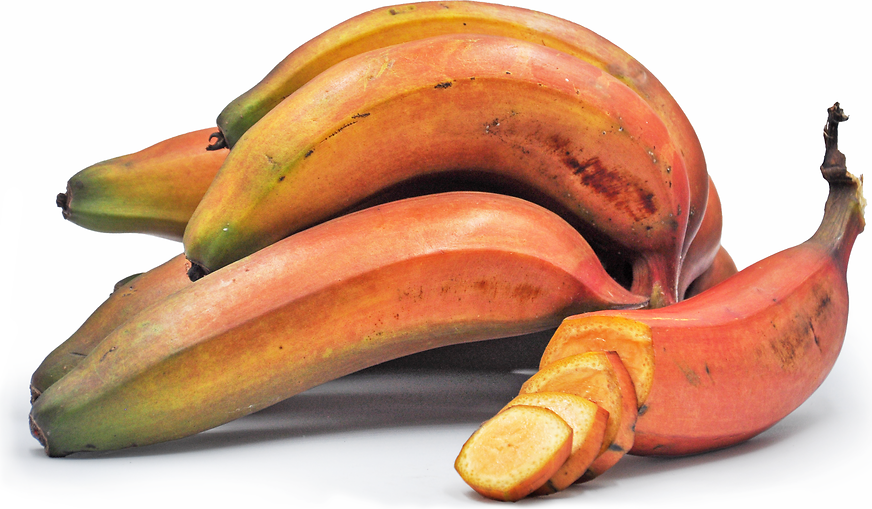
Red Bananas
Estimated Inventory, 20 lbs : 0
This item was last sold on : 08/28/24
Description/Taste
Red bananas are generally smaller than the common yellow cavendish banana, bearing a shorter length, wider diameter, and a curved to straight shape with a few angular ridges extending the length of the fruit. The banana’s peel is thick, tough, and smooth, ripening from green to variegated hues of red-orange, bright red, dark red, yellow, to maroon. The peel’s coloring will vary depending on the fruit’s antioxidant content, and the matte peel may showcase a few blemishes as it gets nicked and bumped in harvest and shipping. As the fruit ripens, the peel will develop several brown spots, a sign of maturity. Once the peel is removed, it reveals a yellow-orange, ivory, to light pink flesh, releasing a fruity and sweet aroma. The flesh is dry, chalky, and unpalatable when raw, but as the banana ripens, the flesh transforms into a creamy, soft, dense, and tender consistency. Red bananas have a mild, sweet, and subtly earthy flavor with tropical, fruity nuances reminiscent of raspberries and mangoes.
Seasons/Availability
Red bananas are available year-round.
Current Facts
Red bananas, botanically classified as Musa acuminata ‘Red Dacca,’ are a subgroup of bananas with red-hued peels belonging to the Musaceae family. The bananas are a part of the AAA genome group, signifying that they are a triploid descendant of wild bananas, and the AAA genome group is the most cultivated type of bananas worldwide. Red bananas are not genetically modified and are a natural grouping of bananas created over time through cultivation and biological selection. Bananas are classified as herbaceous plants and not a tree, and Red banana plants are generally resistant to disease, fast-growing, and tall, producing compact bunches of fruits. Some Red banana varieties can have over one hundred fruits on a single plant. Red bananas are also known as Red Dacca, Red Spanish, Colorado, Red Cuban, Gluay Nak, and Lal Kela and will have many different local names, depending on the region. The bananas are considered a dessert variety and are consumed fresh, favored for their sweet and subtly fruity flavor and soft, dense flesh. Red bananas are not commercially sold on a large scale, but they are a specialty variety that is becoming highly desired for their dense texture, smaller size, lower glycemic index score than yellow bananas, and sweet flavor.
Nutritional Value
Red bananas are a good source of fiber to regulate the digestive tract, potassium to balance fluid levels within the body, magnesium to maintain optimum nerve functioning, and vitamin B6 to monitor amino acid levels within the bloodstream. The bananas also contain more vitamin C and beta-carotene than yellow bananas. Vitamin C strengthens the immune system while reducing inflammation, and beta-carotene is a carotenoid, an antioxidant to support eye health and protect the body against free radical damage.
Applications
Red bananas have a sweet, tropical flavor and dense, creamy flesh suited for fresh and cooked preparations. The fruits can be peeled and eaten straight, out of hand, or they can be sliced and incorporated into fruit bowls, appetizer skewers, or utilized as a fresh topping over pancakes, cereal, oatmeal, other breakfast dishes, and ice cream. Red bananas can also be blended into smoothies, sliced in half and smothered in peanut butter and dried fruits as a snack, or frozen and blended into ice cream. Beyond fresh preparations, Red bananas can be used to sweeten cooked dishes naturally and are popularly sliced and fried into chips, broiled and served with a fresh citrus-infused salsa, baked into banana fries, cooked with beer and brown sugar as a savory-sweet sauce over chicken, or simmered into jam. In Thailand, Red bananas are sometimes used to thicken and sweeten curries. In addition to savory dishes, Red bananas are incorporated into baked goods, tarts, cakes, pudding, and pies. They can also be interchangeably used with yellow bananas in sweet recipes such as banana bread or sliced and dried for extended use. Red bananas pair well with spices such as ginger, cardamom, nutmeg, and cinnamon, fruits including strawberries, mangoes, blueberries, apples, stone fruit, and citrus, lemongrass, nuts such as cashews, hazelnuts, and macadamia, and meats including pork, poultry, and seafood. Whole, unpeeled Red bananas will keep 2 to 10 days when stored at room temperature away from direct sunlight. Red bananas will keep slightly longer than yellow bananas, and it is advised not to store the bananas in the refrigerator as they will develop a mushy, unpleasant texture.
Ethnic/Cultural Info
In Central America, sap from Red banana plants is extracted and consumed as a medicinal elixir, believed to act as an aphrodisiac. The Red banana tree is cut near the ground, and the stump is hollowed to create an empty cavity. This cavity is eventually filled with a sticky, water-filled sap, and the sap is drunk as a specialty beverage to increase fertility. In Peru, Red bananas are used as gifts during celebrations among the Piro tribe, an indigenous community living in the Peruvian jungles. The Piro tribe has several traditions that revolve around bananas. Young males climb banana trees to compete to see who is the fastest. A tribal superstition also states that each end of the banana contains a good side and a bad side. The tribe believes that if you open a banana on the bad side, you are inviting a bad omen into your life. To avoid this, they twist the banana in the middle to avoid the "bad" side.
Geography/History
Bananas are believed by experts to be native to the Indo-Malaysian region and have been growing wild since ancient times. In the early ages, the fruits were spread across Southeast Asia, into northern Australia, and later into Africa. The fruits also eventually made their way to Europe in the 10th century. In the 15th and 16th centuries, Spanish and Portuguese explorers brought bananas from West Africa to Central and South America, where the plants flourished in the New World’s tropical to subtropical regions. Red bananas are thought to have originated in India, and while most of the plant’s history is unknown, over time, the colorful banana subgroup was introduced to banana-growing regions worldwide through trade routes. Bananas were imported into the United States in the late 1800s, and Red bananas were seen in markets of the Eastern United States in the early 1900s. Red bananas were also rumored to have been sold in Toronto markets as early as the 1870s and 1880s. Today Red bananas are a specialty variety sold in American markets, often overshadowed by the famous cavendish banana. Still, the unusual fruits are increasing in popularity as consumers learn about diversity within the Musa genus. Red bananas are also grown and marketed worldwide and can be found in local grocers throughout Southeast Asia, Australia, Africa, the South Pacific, New Zealand, South America, Central America, Canada, and the United States.
Recipe Ideas
Recipes that include Red Bananas. One
| Seven Cloves |
|
Kale Salad with Mango, Red Banana, and White Truffle Olive Oil |
| Kalai's Cooking Recipes |
|
Steamed Simple Caramel Custard with Red Bananas |
Podcast



